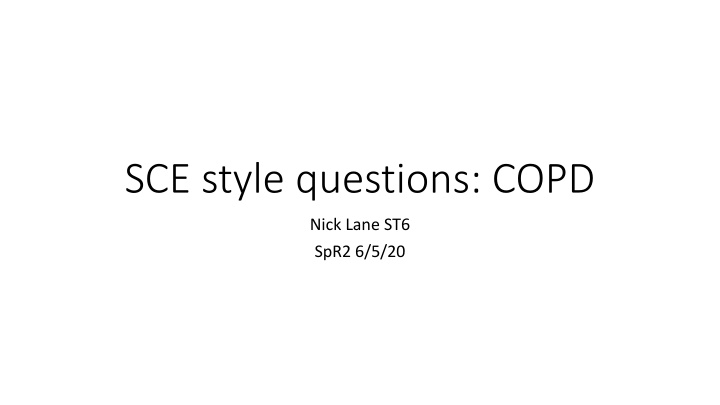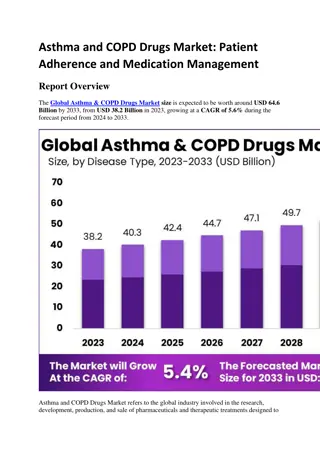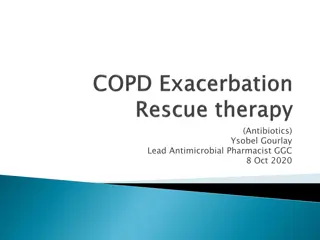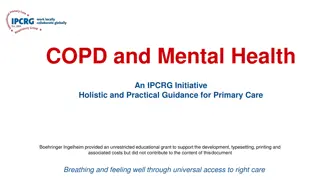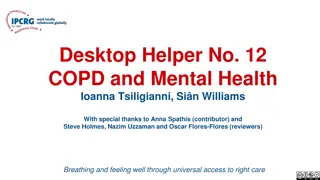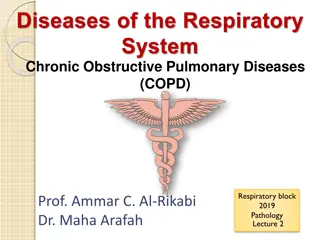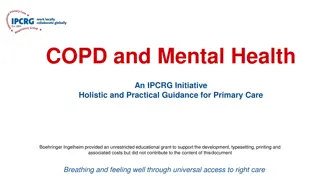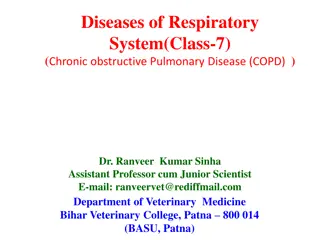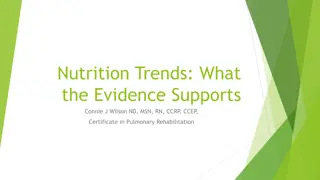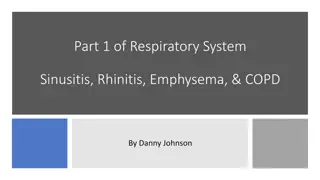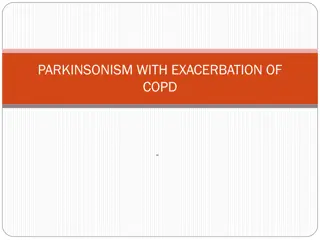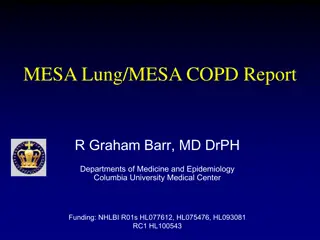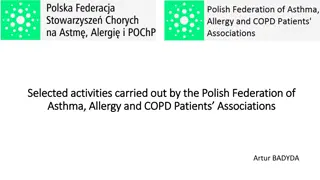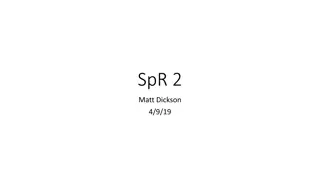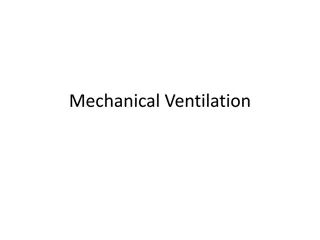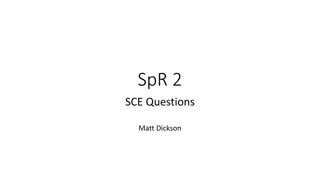SCE style questions: COPD
A 64-year-old man, retired milkman and heavy smoker, presents with chronic cough and breathlessness. Spirometry is indicated, with specific guidelines for bronchodilator use and interpretation. Further questioning reveals hospital admissions for chest infection, antibiotic courses, and lung function results placing him in a specific GOLD group. Learn about the assessment and management of this patient with suspected COPD.
Download Presentation

Please find below an Image/Link to download the presentation.
The content on the website is provided AS IS for your information and personal use only. It may not be sold, licensed, or shared on other websites without obtaining consent from the author.If you encounter any issues during the download, it is possible that the publisher has removed the file from their server.
You are allowed to download the files provided on this website for personal or commercial use, subject to the condition that they are used lawfully. All files are the property of their respective owners.
The content on the website is provided AS IS for your information and personal use only. It may not be sold, licensed, or shared on other websites without obtaining consent from the author.
E N D
Presentation Transcript
SCE style questions: COPD Nick Lane ST6 SpR2 6/5/20
Q1 A 64 year old man is referred to clinic with chronic cough and breathlessness which started around three years ago. He is a retired milkman who lives with his wife. He has smoked 20-30 cigarettes a day for the past 42 years. A chest Xray shows mild hyperinflation of the lung fields You opt to perform spirometry on him. How should this be undertaken: a) Pre- and [10 mins] post- SABA bronchodilator FEV1 and FVC measurement (min x3) b) Post [15-20 mins] SABA bronchodilator FEV1 and [F]VC (min x3) c) FEV1 and [F]VC with no need for bronchodilation (min x3) d) Post [30-45 mins] SABA bronchodilator FEV1 and [F]VC (min x3) e) Pre- and [30-45 mins] post- SABA bronchodilator FEV1 and FVC measurement (min x3)
Q1 A 64 year old man is referred to clinic with chronic cough and breathlessness which started around three years ago. He is a retired milkman who lives with his wife. He has smoked 20-30 cigarettes a day for the past 42 years. A chest Xray shows mild hyperinflation of the lung fields You opt to perform spirometry on him. How should this be undertaken: a) Pre- and [10 mins] post- SABA bronchodilator FEV1 and FVC measurement (min x3) b) Post [15-20 mins] SABA bronchodilator FEV1 and [F]VC (min x3) c) FEV1 and [F]VC with no need for bronchodilation (min x3) d) Post [30-45 mins] SABA bronchodilator FEV1 and [F]VC (min x3) e) Pre- and [30-45 mins] post- SABA bronchodilator FEV1 and FVC measurement (min x3)
Post [15 Post [15- -20 mins] SABA bronchodilator FEV1 and 20 mins] SABA bronchodilator FEV1 and [F]VC x3 [F]VC x3 NICE guidance recommends 15-20 mins post short acting bronchodilator (usually 400mcg salbutamol via a spacer) Ideally patients should stop long acting bronchodilators prior to spirometry for diagnostic spirometry (continue for monitoring spirometry) LABA >8hrs LAMAs >36hrs SABAs >4hrs There is no requirement for pre and post SABA (reversibility testing) if no suspicion of asthma A minimum of three attempts should be performed. <100ml variability (Or <5% variability) between [F]VC manoeuvres is deemed acceptable. No more than 8 should be performed in one sitting. No smoking for >24hrs prior, no large meals or vigorous exercise prior.
Q2 On further questioning, Mr G has been admitted to hospital once over the last 12 months with a chest infection and has had two further courses of antibiotics at home for the same. On one occasion his GP gave him oral corticosteroids. He walks slower than his peers, but manages to walk half a mile with a couple of breaks on a good day. His FEV1 is 53% predicted and his FEV1/FVC is 0.45. Which GOLD group and class does he belong? a) GOLD 2, Group B b) GOLD 3, Group D c) GOLD 1, Group A d) GOLD 3, Group B e) GOLD 2, Group D
A2 On further questioning, Mr G has been admitted to hospital once over the last 12 months with a chest infection and has had two other courses of antibiotics at home for the same. On one occasion his GP gave him oral corticosteroids. He walks slower than his peers, but manages to walk half a mile with a couple of breaks on a good day. His FEV1 is 53% predicted and his FEV1/FVC is 0.45. Which GOLD group and class does he belong? a) GOLD 2, Group B b) GOLD 3, Group D c) GOLD 1, Group A d) GOLD 3, Group B e) GOLD 2, Group D
Description of limitation due to breathlessness MRCD mMRCD eMRCD Breathless only with strenuous exertion 1 0 1 Breathless when hurrying on the level or walking up a 2 1 2 slight hill Walks slower than peers, or stops when walking on 3 2 3 the flat at own pace Stops after walking 100m, or for a few minutes, on 4 3 4 the level Too breathless to leave the house or I am breathless 5 4 n/a when dressing or undressing Too breathless to leave the house unassisted: n/a n/a 5a - But independent in washing and / or dressing - & dependent in washing and dressing n/a n/a 5b
Q3 You decide to start him on inhalers to help with his symptoms (remember: 1 admission, 2 other courses of Abx) In order to assist your decision making, you take some blood tests. U&E normal, CRP 3, Hb 114, WCC 8.6, Eosin 0.12. According to GOLD and local guidance what would be your first choice therapy? a) LABA + LAMA (+SABA) b) LABA + ICS (+SABA) c) LABA + LAMA (+SAMA) d) LABA + LAMA + ICS (+SABA) e) LAMA +ICS (+SABA)
Q3 You decide to start him on inhalers to help with his symptoms (remember: 1 admission, 2 other courses of Abx). In order to assist your decision making, you take some blood tests. U&E normal, CRP 3, Hb 114, WCC 8.6, Eosin 0.14. According to GOLD and local guidance what would be your first choice therapy? a) LABA + LAMA (+SABA) b) LABA + ICS (+SABA) c) LABA + LAMA (+SAMA) d) LABA + LAMA + ICS (+SABA) e) LAMA +ICS (+SABA)
A3: LABA + LAMA (+SABA) A3: LABA + LAMA (+SABA) Evidence from a number of studies that ICS increases risk of pneumonia in COPD. NICE: need for assessment of steroid responsiveness but no further clarity on what that means GOLD suggests that measurement of Eosin <0.1 is likely to give no benefit from ICS, and that >0.3 is, with the middle a bit of grey area His Eosinophils 0.14 therefore toward less benefit NB: Any history of, or suggestive, of asthmatic component should always receive ICS
Q4 Mr G returns to your clinic 9 months later having had 4 courses of antibiotics and steroids from his GP for exacerbations. In the interim period he has also been started on an inhaled corticosteroid. Happily, he has stopped smoking. You consider Azithromycin therapy for him and he is keen. You council him on hearing loss, GI upset and balance disturbance. What else needs to be done? a. Pre-treatment QTc and LFTs, with repeat LFTs at 1/12 b. Pre-treatment QTc and LFTs, with repeat LFTs and QTc at 1-2/12 c. Pre treatment sputum (for NTM), LFTs pre treatment & 1/12 d. Pre treatment sputum (for NTM), LFTs pre treatment & 1/12 and every 6m, Pre treatment QTc e. Pre treatment sputum (for NTM), LFTs pre treatment & 1/12 and 6monthly, plus pre treatment QTc and at 1/12
A4 Mr G returns to your clinic 9 months later having had 4 courses of antibiotics and steroids from his GP for exacerbations. In the interim period he has also been started on an inhaled corticosteroid. Happily, he has stopped smoking. You consider Azithromycin therapy for him and he is keen. You council him on hearing loss, GI upset and balance disturbance. What else needs to be done? a. Pre-treatment QTc and LFTs, with repeat LFTs at 1/12 b. Pre-treatment QTc and LFTs, with repeat LFTs and QTc at 1-2/12 c. Pre treatment sputum (for NTM), LFTs pre treatment & 1/12 d. Pre treatment sputum (for NTM), LFTs pre treatment & 1/12 and every 6m, Pre treatment QTc e. Pre treatment sputum (for NTM), LFTs pre treatment & 1/12 and 6monthly, plus pre treatment QTc and at 1/12
NICE: Pre treatment sputum (for NTM), LFTs pre treatment & 1/12 NICE: Pre treatment sputum (for NTM), LFTs pre treatment & 1/12 and 6monthly, plus pre treatment QTc and at 1/12 and 6monthly, plus pre treatment QTc and at 1/12 Macrolide treatment is of benefit in non-smokers with COPD >3 exacerbations AND >1 admission ECG for QTc should be performed before treatment and again at 1month. If there is QTc prolongation at 1m, it should be discontinued LFTs should be performed at baseline and 1month, plus every 6 months thereafter Sputum culture should be performed prior to treatment (primarily for NTM). If NTM is detected, macrolide monotherapy should be avoided. Macrolides should be continued initially for at least 6 months with measurement of benefit (change in exacerbation, CAT score, QoL etc) A dose of 250mg MWF is adequate for most Azithromycin does not need to be stopped during exacerbation unless other QTc prolonging treatment is provided CT should be considered to assess for bronchiectasis
Q5 Its 0105, you are on nightshift and particularly excited as Mr G has come into the ED whilst you are assessing [yet another] mixed overdose patient. He grabs your attention as he is on 15L via a non-rebreathe mask and an ABG shows ph 7.29, CO2 9.7, O2 18.7, BE 29. You judiciously adjust his oxygen to a venturi and ask the SHO in ED to perform an ABG along with other emergency medical treatment. CXR shows no pneumothorax, but possible pneumonia at the right base. Obs are stable. The repeat ABG result is called through to you. Time 0150, FiO2 28%, pH 7.33, CO2 8.2, O2 9.3, HCO3 31, BE -2. What is the next best management step? a) Further titrate O2 as improving pH and pCO2 and repeat ABG after further hour b) Commence NIV within the next two hours and repeat ABG within 2hrs of starting c) Commence NIV within the next hour and repeat ABG within 2hrs of starting d) Do not commence NIV and refer to HDU for pneumonia treatment e) Refer for mechanical ventilation
Q5 Its 0105, you are on nightshift and particularly excited as Mr G has come into the ED whilst you are assessing [yet another] mixed overdose patient. He grabs your attention as he is on 15L via a non-rebreathe mask and an ABG shows pH 7.29, CO2 9.7, O2 18.7, BE 29. You judiciously switch to controlled O2, and ask the SHO to repeat an ABG, along with other emergency medical treatment. CXR shows no pneumothorax, but possible pneumonia at the right base. Obs are stable. The repeat ABG result is called through to you. Time 0150, FiO2 28%, pH 7.33, CO2 8.2, O2 9.3, HCO3 31, BE -2. What is the next best management step? a) Further titrate O2 as improving pH and pCO2 and repeat ABG after further hour b) Commence NIV within the next two hours and repeat ABG within 2hrs of starting c) Commence NIV within the next hour and repeat ABG within 2hrs of starting d) Do not commence NIV and refer to HDU for pneumonia treatment e) Refer for mechanical ventilation
A5: Commence NIV within the next hour and repeat ABG A5: Commence NIV within the next hour and repeat ABG within 2hrs of starting within 2hrs of starting Patient has hypercapnic respiratory failure on BG COPD pH low, CO2 >6.5kPa NIV reduces inpatient mortality by 50% BTS Quality standards 2018 Pts should start NIV within 60mins of ABG that prompts treatment Pts should start within 120min of hospital arrival if acute presentation If acidosis persists after >30mins of targeted O2 therapy, NIV should start ABGs should be performed within 2hrs of NIV starting to assess for pH and pCO2 improvements BTS/ICS NIV guidelines Pneumonia not a contraindication to NIV in condition which would otherwise benefit from NIV (COPD, OHS, Neuromuscular) If pH <7.25 and no clinical signs of PTx, start NIV before CXR
Q6 The SHO from the emergency department is very enthusiastic for 2am, and asks you what the primary mechanism behind oxygen induced type two (acute hypercapnic) respiratory failure is. a) It s a myth, titrate oxygen to normal saturations b) The Haldane effect c) Distal absorption atelectasis d) Loss of hypoxic pulmonary vasoconstriction e) Loss of hypoxic drive
Q6 The SHO from the emergency department is very enthusiastic for 2am, and asks you what the primary mechanism behind oxygen induced type two (acute hypercapnic) respiratory failure is. a) It s a myth, titrate oxygen to normal saturations b) The Haldane effect c) Distal absorption atelectasis d) Loss of hypoxic pulmonary vasoconstriction e) Loss of hypoxic drive
A6 (BTS emergency O2 guidelines are good!) HPV: V/Q matching in COPD is partly maintained by hypoxic pulmonary vasoconstriction (HPV) Alveolar hypoventilation = less blood flow to that lung unit If high FiO2 this increases PAlveolarO2, which reverses HPV That lung unit is still under-ventilated (low gas exchange), but with increased blood flow therefore worsening whole lung V/Q mismatch. Worse mismatch = less CO2blown off Hypoxic drive: In patients with significant hypoxia (primarily <8.0kpa), high flow O2 reduces tidal volume and RR transiently by around 20%, worsening alveolar hypoventilation. Halving alveolar ventilation ~ doubles PaCO2. ( PaCO2 = 0.863 x (VCO2/VA) ) This effect usually corrects to ~90% of normal within 20 mins The effect of this is relatively limited once PaO2 >8kPa, and attenuates completely >13kPa PaO2 Therefore, if PaO2 >13 this is not likely to be the only mechanism of O2 induced T2RF
A6 part 2 Haldane effect More oxygenated haemoglobin has lower affinity for CO2 in venous circulation, leading to higher PaCO2 Absorption atelectasis Increased absorption of O2 in alveoli with high PAO2 causes atelectasis, this occurs beyond obstructed/mechanically unstable airways and results in a shunt (increased V/Q mismatch). Oxygen density Higher density and viscocity than air, therefore potentially increased work of breathing (esp. if patient exhausted) Potential rebreathing if low flow rates used through face masks
Q7 You follow Mr G up in clinic following his admission. He s recovered well and has been attending pulmonary rehabilitation and found benefit in this. Despite his treatments, he s now had total 6 exacerbations this year including one hospitalisation with T2RF. He coughs and produces sputum on most days. You want to start him on Roflumilast. Regarding Rofumliast s mechanism of action a) It is a Phosphodiesterase type-4 agonist b) It is a methylxanthine c) It is a Phosphodiesterase type-4 inhibitor d) It is a tyrosine kinase inhibitor e) Analeptic agent with K channel inhibition
Q7 You follow Mr G up in clinic following his admission. He s recovered well and has been attending pulmonary rehabilitation and found benefit in this. Despite his treatments, he s now had total 6 exacerbations this year including one hospitalisation with T2RF. He coughs and produces sputum on most days. You want to start him on Roflumilast. Regarding Rofumliast s mechanism of action a) It is a Phosphodiesterase type-4 agonist b) It is a methylxanthine THEOPHYLLINE c) It is a Phosphodiesterase type-4 inhibitor ROFLUMILAST d) It is a tyrosine kinase inhibitor NINTEDANIB e) Analeptic agent with K channel inhibition DOXAPRAM
Q8 Before you write the prescription, you check the BNF and find that Roflumilast can only be prescribed in certain situations. What criteria must Mr G fulfil before you can prescribe him Roflumilast? a) FEV1 <50% predicted and two or more exacerbations on triple therapy inhalers b) FEV1 <50% predicted, plus two or more exacerbations on triple therapy inhalers and long term macrolide therapy c) FEV1 <30% predicted, at least one severe (hospitalised) exacerbation and RV >130% d) FEV1 <80% predicted, two or more exacerbations and CAT score >10 on optimal inhaled therapy e) 4 exacerbations in the last 12 months with mMRCD >2 despite completion of pulmonary rehab on triple therapy inhalers.
A8 Before you write the prescription, you check the BNF and find that Roflumilast can only be prescribed in certain situations. What criteria must Mr G fulfil before you can prescribe him Roflumilast? a) FEV1 <50% predicted and two or more exacerbations on triple therapy inhalers b) FEV1 <50% predicted, plus two or more exacerbations on triple therapy inhalers and long term macrolide therapy c) FEV1 <30% predicted, at least one severe (hospitalised) exacerbation and RV >130% d) FEV1 <80% predicted, two or more exacerbations and CAT score >10 on optimal inhaled therapy e) 4 exacerbations in the last 12 months with mMRCD >2 despite completion of pulmonary rehab on triple therapy inhalers.
A8 FEV1 <50% predicted and two or more exacerbations on triple therapy inhalers NICE state Add on to bronchodilator therapy (stated as triple therapy with LAMA, LABA, ICS) FEV1 <50% post bronchodilator Two or more exacerbations in the last year Must be prescribed by respiratory specialist Interestingly, not allowed in Scotland Common SEs Low appetite/weight loss (think carefully in low BMI patients) Diarrhoea/GI upset Headache
